Are you faced with choosing between TeamDynamix vs. Jira Service Management as your preferred IT Service Management (ITSM) platform? The ITSM landscape offers a wealth of options, each promising to meet your unique needs, leaving you with a complex decision.
In this blog post, we're set to embark on a comprehensive head-to-head ITSM tools comparison, pitting these two prominent contenders against each other in the ITSM arena.
But neither of these solutions may fully meet the specific demands of your organization. That's why we're introducing a third alternative: InvGate Service Management. This robust service desk software is purpose-built to streamline service delivery and empower organizations to elevate their ITSM practices to unprecedented efficiency and excellence.
So, if you're eager to find the ITSM platform that has the potential to revolutionize your organization's Service Management capabilities, read on.

Table of contents
- TL;DR
- What is TeamDynamix?
- What is Jira Service Management?
- Considering InvGate Service Management as an ITSM solution alternative
TL;DR
- TeamDynamix garners positive feedback for its customization options, user-friendly interface, and reliable ticketing module. However, criticisms arise regarding integration challenges, complexities in Ticket Management, and an outdated user interface.
- Jira Service Management is recognized for streamlined sprint planning, efficient ticketing, and flexible pricing, yet faces challenges with complex migration, limited integrations, and reported issues with support and UI.
- Meanwhile, InvGate Service Management offers streamlined ITSM setup, flexible deployment, robust ticketing, incident management, and self-service capabilities, emphasizing cost-effectiveness, innovation, and IT Asset Management integration.
We tried to be as thorough as possible, but if you don't have enough time to read it through and through, here's (another) TL;DR: InvGate Service Management can do everything we say here, and you can test it right away for free for 30 days.
Most looked-at features by buyers
When users assess their options for IT Service Management solutions, they concentrate on specific features that align with their organization's requirements. It is crucial to comprehend these desired functionalities to make well-informed decisions.
Now, let's delve into the primary factors that potential purchasers typically consider when comparing ITSM tools.
- Customization and adaptability - Buyers favor software solutions that can be customized to align with their business needs. This ensures that the software accommodates their unique workflows and processes, ultimately increasing user satisfaction and operational efficiency.
- User-friendly experience and interface - Ease of use and interface design are pivotal considerations for buyers. They highly value a user-friendly platform with an intuitive interface that enhances user adoption and productivity. Mobile accessibility is also critical, especially for remote or mobile workforce organizations.
- Ticket Management System - Prospective buyers attach significant importance to a comprehensive Ticket Management system integrated into the help desk software. This functionality facilitates efficient tracking, assignment, and resolution of customer inquiries and support requests.
- Scalability - Organizations with evolving requirements prioritize solutions that can adapt to their growth and allow customization. Buyers specifically seek the ability to create custom fields, workflows, and extensions/plugins to meet their unique business needs.
- Simplified IT service catalog - Organizations often require a simplified IT service catalog that offers a centralized platform for users to request specific IT services or resources. This simplification streamlines service requests, improves visibility, and aids in effective service delivery management.
- Self-service portal and knowledge base - Including a self-service portal is highly prized as it empowers end-users to independently resolve common issues and access pertinent information without requiring direct assistance.
- Support automation and Workflow Management - Buyers seek software solutions with automation capabilities to streamline routine tasks such as ticket routing, approvals, and escalations. These automation features contribute to increased efficiency and productivity.
- Informative reporting - Buyers actively seek help desk software equipped with robust reporting tools like dashboards and reports. These features offer valuable insights into IT operations and performance, aiding in informed decision-making and continuous service improvement.
- Seamless integration capabilities - The ability to integrate with other systems and applications is a vital requirement for buyers. They seek a seamless data flow and automated processes, valuing the capability to integrate with existing tools and platforms to enhance efficiency and provide a unified user experience.
- Cost and support - Buyers evaluate the solution's overall cost-effectiveness, considering licensing models, subscription plans, and any additional expenses related to features or users. The availability of dependable customer support, comprehensive documentation, and accessible training resources significantly influences their decision-making.
- Efficient IT Asset Management - Users prioritize software that offers robust IT Asset Management capabilities, aiding in maintaining accurate inventories and optimizing resource utilization within their organizations.
- ITIL compliance - Many organizations prioritize adherence to ITIL best practices. Therefore, buyers may favor solutions that support ITIL processes, including Incident Management, Problem Management, Change Management, and Asset Management.
What is TeamDynamix?
TeamDynamix is a cloud-deployed system offered through a Software-as-a-Service (SaaS) model 2ithin the realms of IT Service Management, Project Portfolio Management (PPM), and Integration Platform as a Service (iPaaS). This technology enables educational institutions, such as colleges, universities, and other entities, to align, cooperate, and enhance their work management procedures.
What users like from TeamDynamix
TeamDynamix has received positive user reviews from reputable industry sources like Gartner, highlighting several notable strengths and advantages of the platform. Let's delve into these benefits in greater detail.
- Extensive customization - Users appreciate the wide range of customization options TeamDynamix offers. These options empower them to tailor the platform precisely to their unique requirements, allowing for the creation of customized workflows and processes.
- Powerful dashboards - TeamDynamix features robust dashboards that provide teams with potent management tools. These dashboards make it easy for team members to monitor progress and collaborate effectively, ultimately boosting overall productivity.
- Intuitive user experience - TeamDynamix has a user-friendly interface that simplifies the assignment and management of tasks and the submission of requests. Users find it remarkably easy to navigate, significantly enhancing their efficiency in daily tasks.
- Seamless implementation - One standout feature of the platform is its effortless implementation, requiring no prior programming expertise. This accessibility lowers entry barriers for organizations, ensuring a straightforward onboarding process.
- Responsive customer support - Users consistently commend the responsiveness and helpfulness of TeamDynamix's support team. They receive timely assistance when facing challenges or seeking guidance, contributing to a smoother overall user experience.
- Reliable ticketing system - The ticketing module consistently receives praise for its reliability and robustness. It equips users with the tools to efficiently organize and track project tickets, streamlining project management efforts.
What users don’t like from TeamDynamix
While TeamDynamix has many strengths and positive attributes, it has not been immune to user criticism, particularly in reviews from reputable sources such as Gartner. Here are some of the issues that have surfaced and warrant attention:
- User interface complexity - Complaints have arisen regarding TeamDynamix's user interface complexity. Users have faced issues with an outdated layout, limited customization options, and awkward ticket and comment layouts. Many advocate for a more modern, user-friendly graphical user interface (GUI).
- Integration challenges with ITSM suites - Users have voiced frustration over the platform's inability to integrate with a complete IT Service Management suite seamlessly. Additionally, they have noted a deficiency in robust Change and Configuration Management software.
- Limited desktop sharing and updates - Concerns have been raised about the platform's inability to facilitate desktop sharing and its infrequent updates once they are released. This limitation has restricted flexibility and usability for certain organizations.
- Ticket Management challenges - Users have reported various difficulties in managing tickets. These include the inability to sort tickets by due date, challenges with the workflow designer, and the absence of basic functions like batch deletion in Asset Management.
- Limited reporting capabilities - Some users have found the reporting capabilities within the system to be lacking. They desire more extensive integration between project and ticketing applications to enhance their ability to generate and analyze reports effectively.
- Delayed enhancement addressing - Users have expressed frustration over lengthy wait times for enhancements to be addressed, impacting their ability to utilize the platform effectively.
- Permissions management challenges - Reports have emerged about difficulties in how the vendor handles write/view/access permissions. These issues have raised concerns about user access and security.
- Outage page accessibility - Requiring login to access the outage page has been seen as an impediment, preventing users from obtaining critical information during system downtime.
- Complex workflow structures - TeamDynamix has faced criticism for its intricate workflow structures, which have posed navigation and implementation challenges for some users.
- Limited support - A significant drawback that has garnered attention is the platform's inadequate support during critical outages. Users have reported feeling left without assistance during crucial downtime situations. Furthermore, some have expressed dissatisfaction with the level of assistance provided through direct support channels.
- Need for user experience enhancement - While generally considered user-friendly, some users have encountered challenges in their overall experience. Specifically, they have found sorting and searching for tickets less intuitive. The abundance of customization options has also overwhelmed some users.
What’s TeamDynamix’s argument over Jira Service Management?
To discern TeamDynamix's compelling arguments compared to Jira Service Management, let’s delve deeply into the unique strengths that differentiate the former.
- Extensive customization options - TeamDynamix empowers users with customization options that enable organizations to configure the platform precisely to their unique needs.
- Agile dashboards - TeamDynamix offers agile dashboards with potent management tools. These dashboards facilitate seamless team monitoring and collaboration.
- User-friendly interface - TeamDynamix prides itself on a user-friendly interface that simplifies task assignment, request management, and overall navigation.
- Effortless implementation - TeamDynamix sets itself apart with an effortless implementation process, requiring no prior programming expertise. This accessibility lowers barriers to entry for organizations.
- Responsive support - Users consistently laud TeamDynamix's responsive and helpful customer support team.
- Unwavering ticketing module - The ticketing module within TeamDynamix earns praise for its unwavering reliability and robustness. Users find it indispensable for organizing and tracking project tickets with efficiency.
What is Jira Service Management?
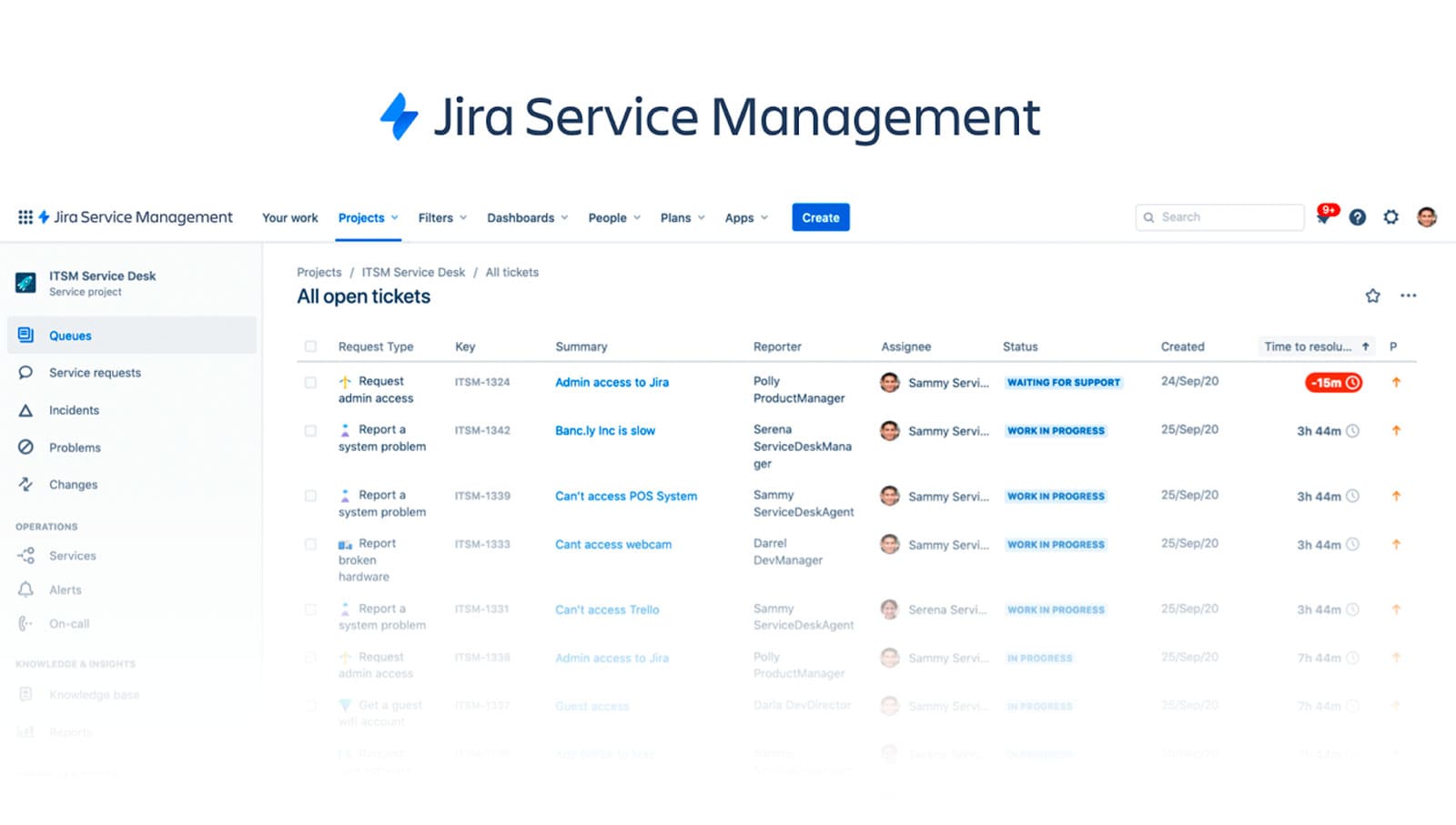
Jira Service Management, developed by Atlassian, is an IT Service Management platform renowned for its user-friendly interface and robust features, which empower businesses to enhance service delivery and elevate customer satisfaction. Presently, Jira Service Management is available in a cloud-based version, enabling organizations to tap into the benefits of cloud computing for their Service Management needs.
Atlassian, the company behind Jira, was founded in 2002 by Mike Cannon-Brookes and Scott Farquhar, with its roots in Sydney, Australia. Over the years, the company has grown substantially, establishing offices in various countries across the globe.
Atlassian specializes in crafting software and tools tailored to cater to the requirements of developers and project managers. These encompass diverse needs, including project management, issue tracking, collaborative content creation, code management, and team coordination. Some notable offerings from Atlassian include Confluence, Bitbucket, and Trello.
What users like from Jira Service Management
Analysis conducted by respected sources such as Gartner and G2 has highlighted the positive feedback received from users of Jira Service Management. Here are some notable benefits that have been acknowledged:
- Intuitive and user-friendly interface - Users highly appreciate the platform's intuitive interface, which enhances incident and request management. The design promotes user-friendliness, enabling teams to navigate and interact with the system effortlessly.
- Efficient ticketing system with customizable workflows - The ticketing system and customizable workflows simplify task management, making it easy for teams to track and prioritize tickets based on their specific requirements.
- Enhanced user portal for self-service - Jira Service Management's platform features an improved user portal that elevates the self-service experience. This portal empowers users to independently assess incidents and requests, allowing them to resolve issues whenever possible. Additionally, users can rate the overall process after issue resolution, providing valuable feedback for continuous improvement and bolstering customer satisfaction efforts.
- Comprehensive task details and robust filtering capabilities - Users value the abundance of task details that provide in-depth insights into each task. This feature equips teams with a complete understanding of their work. Furthermore, the platform offers robust filtering capabilities, enabling users to search, sort, and organize tasks based on specific criteria, ultimately enhancing productivity.
- Streamlined sprint planning and task assignment - Jira Service Management seamlessly integrates with popular collaboration platforms like Slack and Teams, streamlining sprint planning and task assignment. The Kanban view serves as a centralized hub for task management, while the tagging feature enables efficient organization of project-specific tasks.
- Flexible pricing options - Jira Service Management offers a range of flexible pricing options suitable for organizations of varying sizes and budgets. This includes a free plan designed for small teams of up to three users with 2 GB of storage. The cloud-hosted option provides a reasonably priced base package.
What users don’t like from Jira Service Management
Despite its many strengths and positive aspects, Jira Service Management has not remained immune to criticisms and concerns voiced by its users. Here are recurring issues that have been identified through analyses conducted by reputable sources like Gartner and G2:
- A steep learning curve - The platform's extensive capabilities and functionalities can present a steep learning curve for users. This complexity may necessitate additional guidance or training for individuals to navigate and utilize the system and its features effectively.
- Complex migration process - Users have expressed frustration with the intricacies of migrating their projects to Jira Service Management. Some have encountered difficulties that may require an additional user subscription, adding complexity to the migration process.
- Limited and complex integrations - Users have voiced a desire for more straightforward integrations and have often resorted to creating custom solutions to connect Jira Service Management with specific tools. Integrating the platform with external systems has proven to be challenging and time-consuming.
- Task tracking and reporting limitations - Users have encountered limitations in tracking tasks and generating reports, hindering their ability to monitor and analyze project progress and performance effectively. This includes challenges when managing multiple tasks, creating comprehensive reports, and customizing dashboards within the platform.
- Reliance on additional plugins - Users have found it necessary to depend on additional plugins to access basic features within the system. Additionally, complying with data protection regulations like GDPR has posed challenges for some users.
- Issues with Atlassian support - Users have reported difficulties obtaining assistance from Atlassian support. Securing the necessary support and guidance has proven challenging for some, potentially affecting their overall experience with the platform.
- Less intuitive interface - Compared to alternative options, some users have perceived Jira Service Management's interface as less intuitive, particularly when external customers interact with the platform.
What’s Jira Service Management’s argument over TeamDynamix?
When considering Jira Service Management in comparison to TeamDynamix, it's essential to explore the distinct advantages that Jira Service Management offers as a robust IT Service Management solution.
- Intuitive and user-friendly interface - Jira Service Management's user-friendly interface simplifies incident and request management, enhancing operational efficiency and user adoption. Users find it easy to navigate and interact with the system.
- Efficient ticketing system with customizable workflows - The ticketing system in Jira Service Management streamlines task management. Its customizable workflows allow teams to tailor processes to their needs, ensuring efficient incident and request handling.
- Enhanced self-service portal - Jira Service Management features an improved self-service portal that empowers users to independently assess and resolve incidents and requests. This self-help capability not only reduces the workload on IT staff but also boosts customer satisfaction.
- Comprehensive task details and robust filtering - Users appreciate the wealth of task details that provide in-depth insights into each task. The platform's robust filtering capabilities enable users to search, sort, and organize tasks based on specific criteria, enhancing productivity and organization.
- Streamlined integration and collaboration - Jira Service Management seamlessly integrates with popular collaboration platforms like Slack and Teams, simplifying sprint planning and task assignment.
- Flexible pricing options - Jira Service Management offers a range of flexible pricing options, making it suitable for organizations of various sizes and budgets.
Considering InvGate Service Management as an ITSM solution alternative

While TeamDynamix and Jira Service Management are recognized players in IT Service Management, exploring alternative solutions tailored to your organization's specific needs is crucial. In this context, InvGate Service Management is a compelling choice that warrants thorough consideration.
Let's delve into the comprehensive features of InvGate Service Management that position it as a valuable option for meeting your organization's ITSM requirements:
Simplified configuration and setup
InvGate Service Management streamlines the configuration and setup process with a user-friendly, no-code/low-code approach. This approach empowers both novice and experienced users to implement the system without requiring extensive technical expertise. The platform offers straightforward configuration options, allowing organizations to leverage its robust ITSM capabilities quickly.
Customization and flexibility
InvGate Service Management provides flexible deployment options, offering both on-premise and cloud-based solutions. This flexibility ensures the platform can meet the specific demands of various sectors and industries.
Exceptional user experience
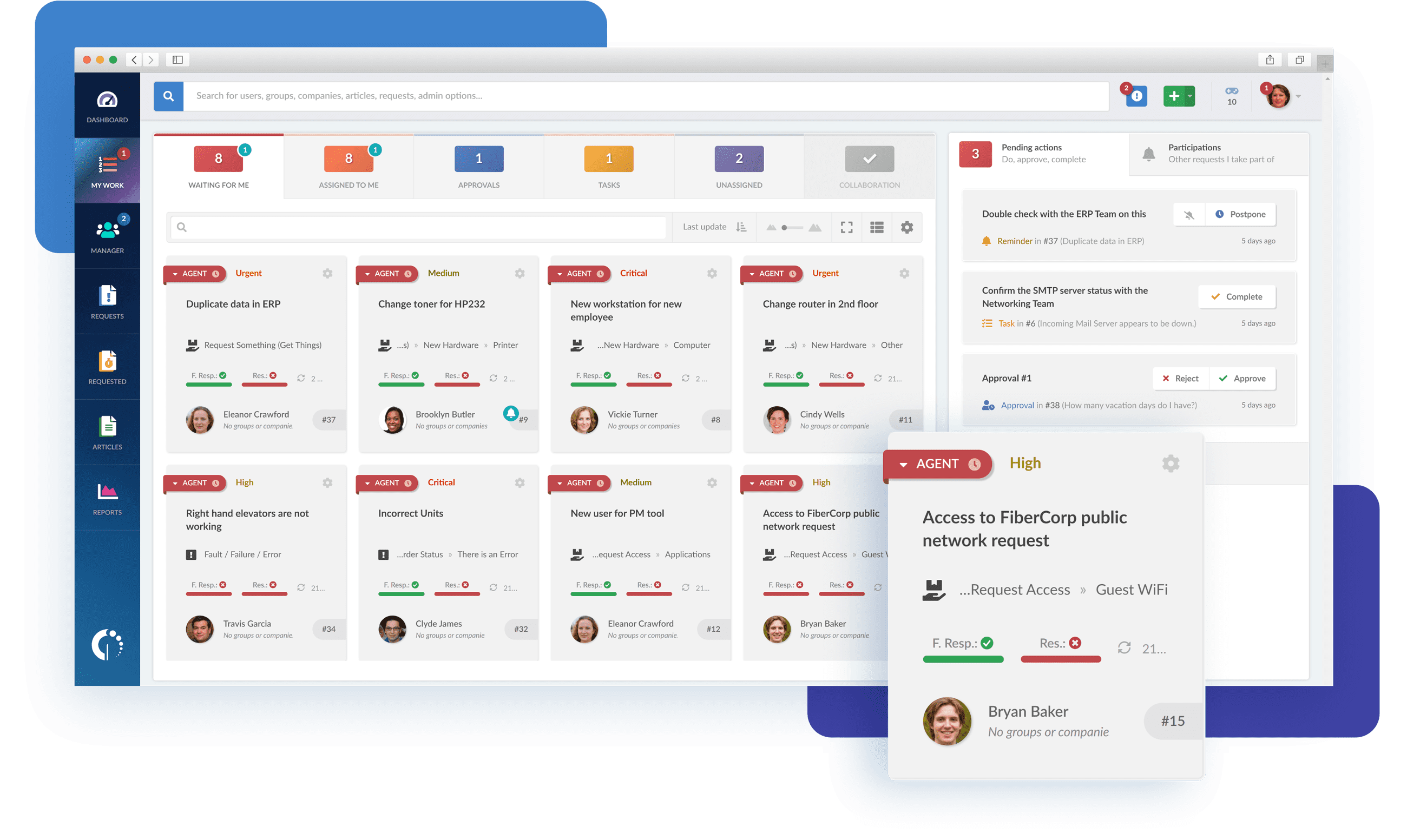
InvGate Service Management strongly emphasizes delivering an exceptional user experience through careful design and adherence to UI/UX best practices. Its intuitive interface promotes rapid adoption, reducing the need for extensive training and maximizing overall productivity.
Robust Ticketing and Incident Management
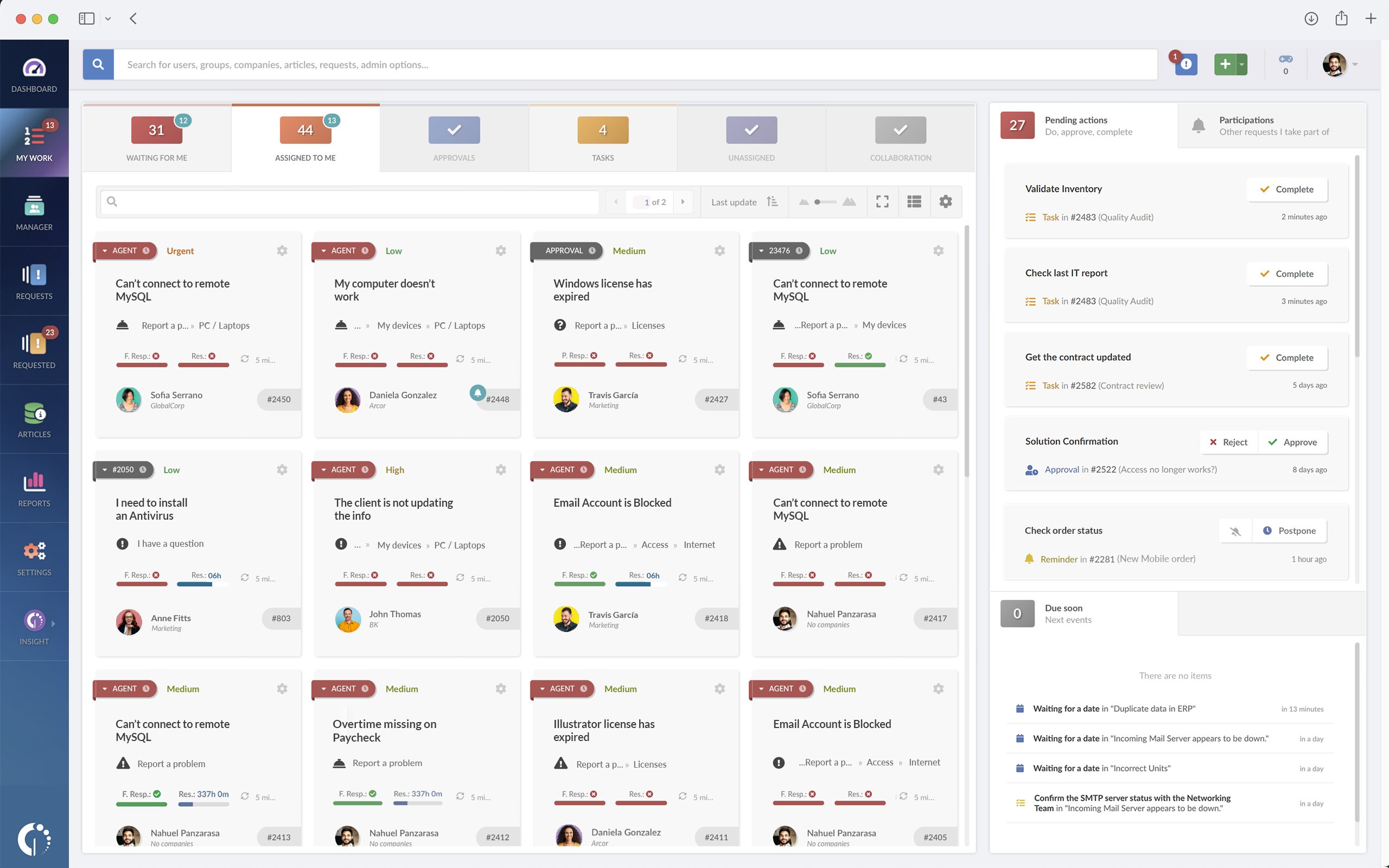
InvGate Service Management offers powerful capabilities for efficient ticket tracking, collaboration, and incident resolution. Features such as automated ticket routing, customizable workflows, and SLA Management enable IT teams to manage and prioritize incidents effectively.
Strong self-service capabilities
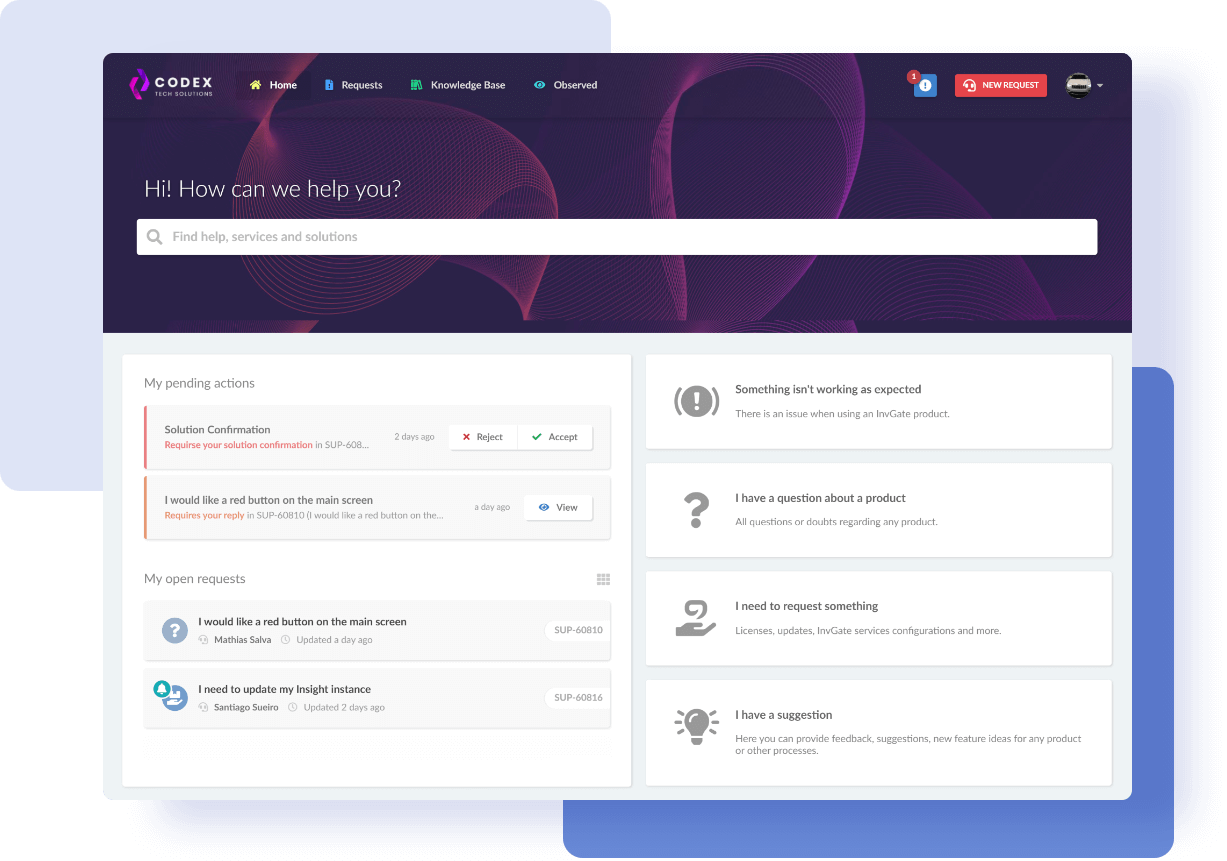
InvGate Service Management offers robust self-service functionalities, including a user-friendly portal, an extensive IT service catalog, and a knowledge base. These features empower end-users to independently address common issues, access various IT services, and utilize self-help resources, thus reducing the workload on IT staff.
Comprehensive reporting and analytics
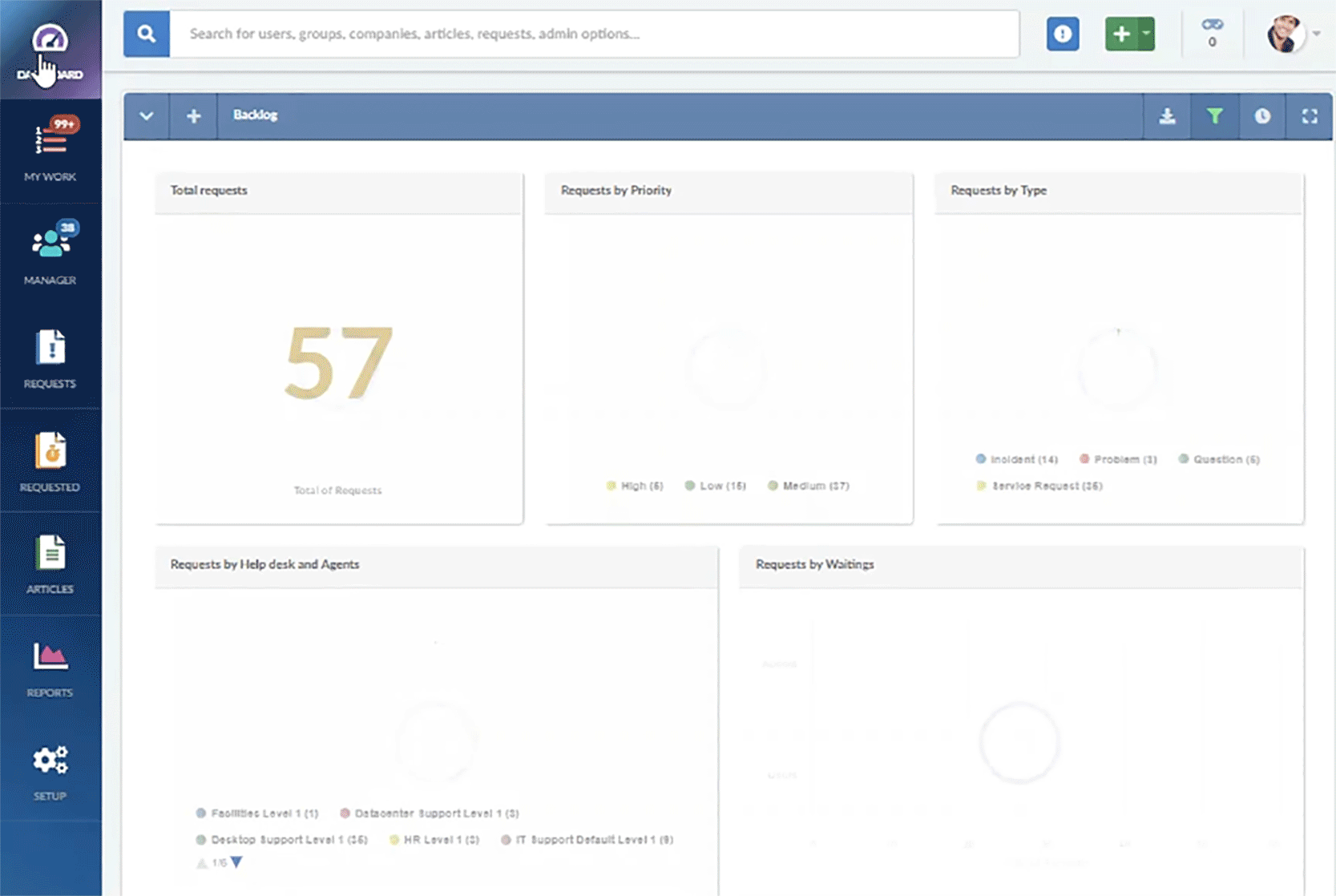
InvGate Service Management provides extensive reporting and analytics functionalities, allowing organizations to gain valuable insights into their IT operations and performance. The platform offers ready-to-use reports and customizable dashboards, enabling IT teams to analyze data, identify patterns, and make informed decisions to enhance their services.
Comprehensive Asset Management
By integrating InvGate Service Management with InvGate Asset Management, organizations gain a comprehensive view of their IT ecosystem. This integration improves service delivery and reduces downtime, offering features such as IT Asset Discovery, Inventory Management, Software License Management, and maintenance schedules.
ITIL-certified readiness
InvGate Service Management holds the prestigious ITIL4 certification from PINK Elephant, demonstrating its commitment to maintaining ITSM excellence. Whether organizations are embarking on their ITIL journey or managing complex operations, InvGate Service Management offers a user-friendly and feature-rich experience aligned with industry best practices.
Cost-effective solution
InvGate Service Management offers a cost-effective solution without compromising on functionality. It provides a comprehensive suite of ITSM features at a competitive price point, making it an appealing choice for organizations seeking affordability without sacrificing capabilities. Compared to alternatives like TeamDynamix and Jira Service Management, InvGate Service Management strikes a balance between cost and functionality.
Focused on ITSM with ESM extension
InvGate Service Management is purpose-built for ITSM and seamlessly extends its capabilities to Enterprise Service Management (ESM). This empowers operational departments to enhance their processes and fully embrace the advantages of digital transformation. With a primary focus on ITSM and strong performance in ESM, InvGate Service Management facilitates streamlined workflows and comprehensive digital transformation initiatives across all departments.
Fast ROI and ongoing innovation
InvGate Service Management ensures a swift return on investment through efficient implementation processes. Within weeks, organizations can begin enjoying the benefits of this robust ITSM solution. Additionally, regular feature updates keep users at the forefront of technology without incurring additional costs.
Next steps
In the quest to determine your organization's ideal IT Service Management solution, the TeamDynamix vs. Jira Service Management debate has unveiled unique strengths and capabilities on both sides.
However, the ITSM landscape is rich with contenders, and one more compelling player deserves your attention: InvGate Service Management. This platform offers streamlined functionalities and robust features that have the potential to elevate your IT services and drive your digital transformation journey. Explore our live demo to appreciate its transformative capabilities.
















